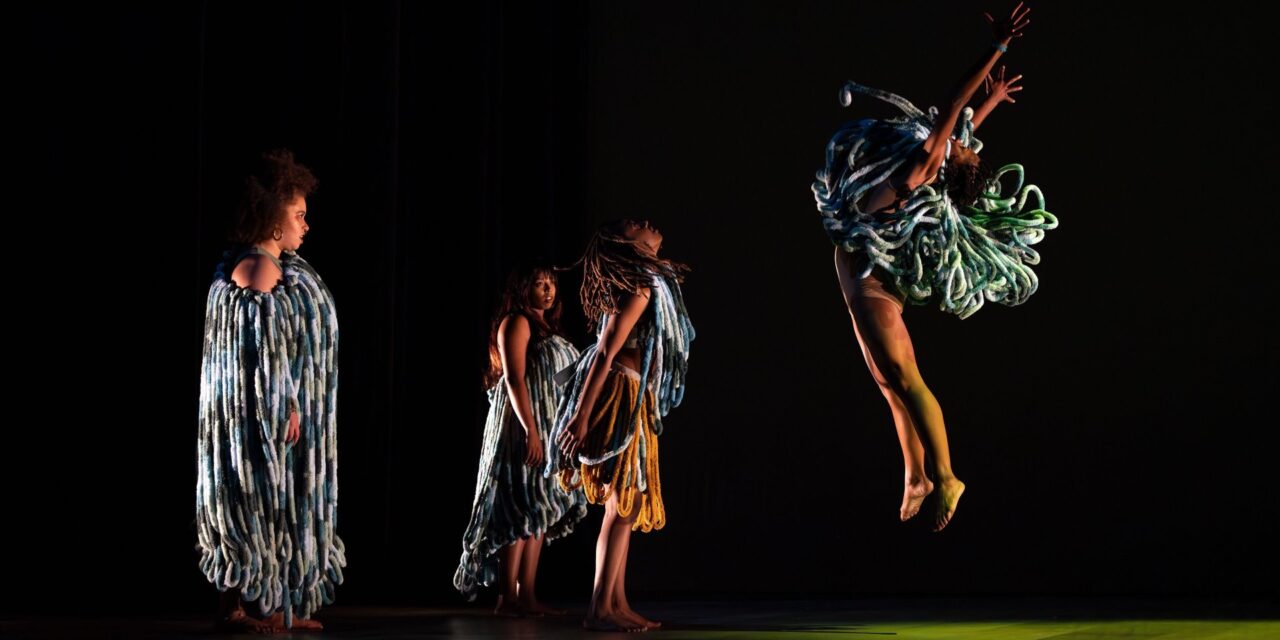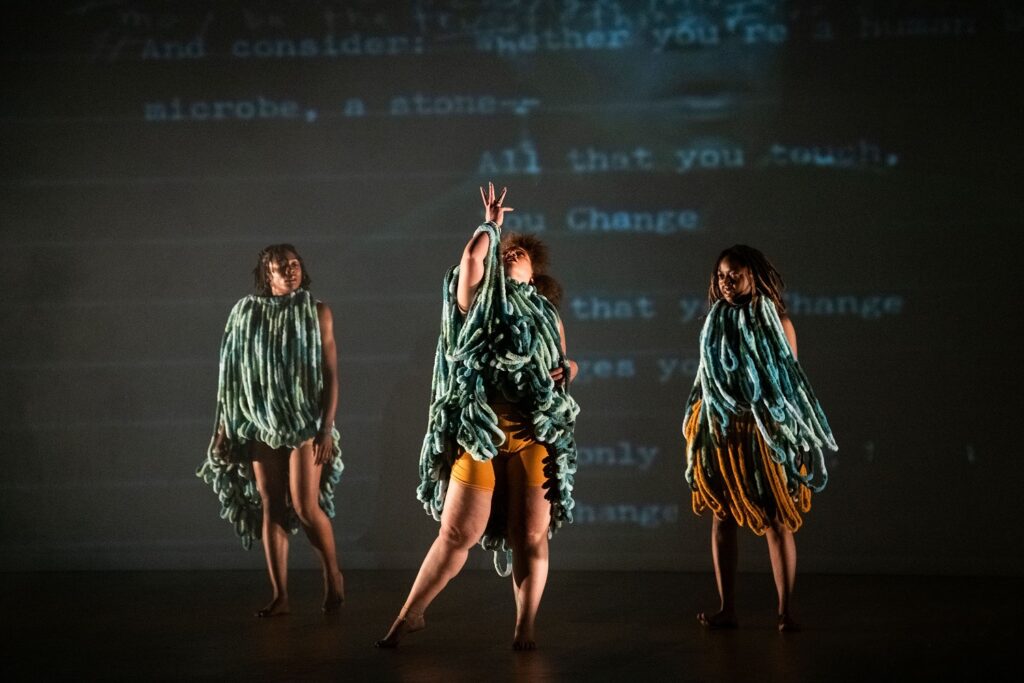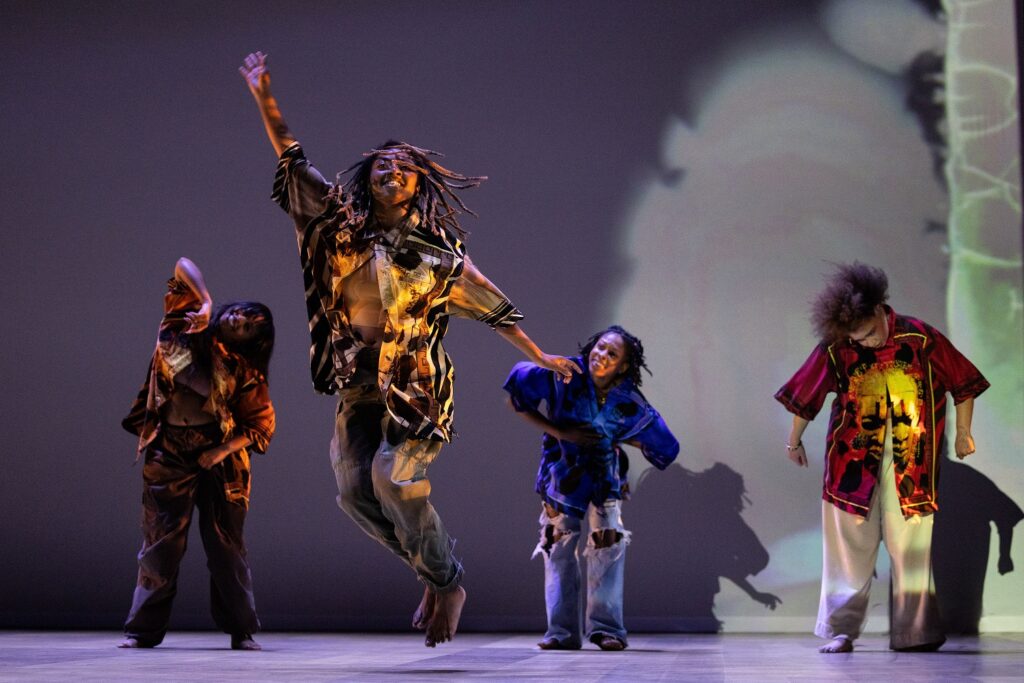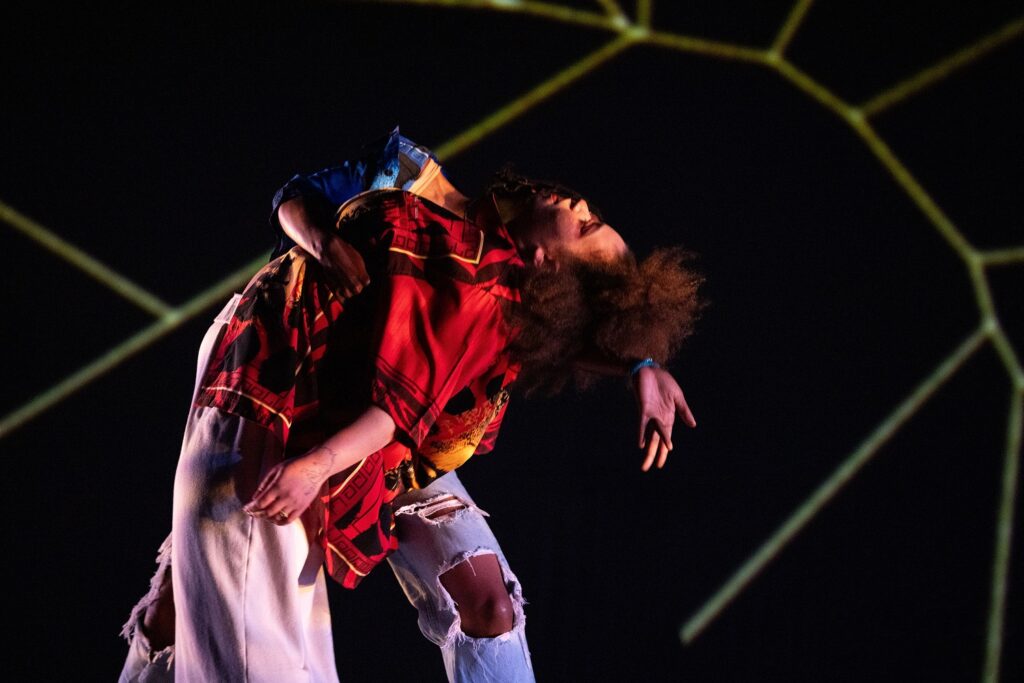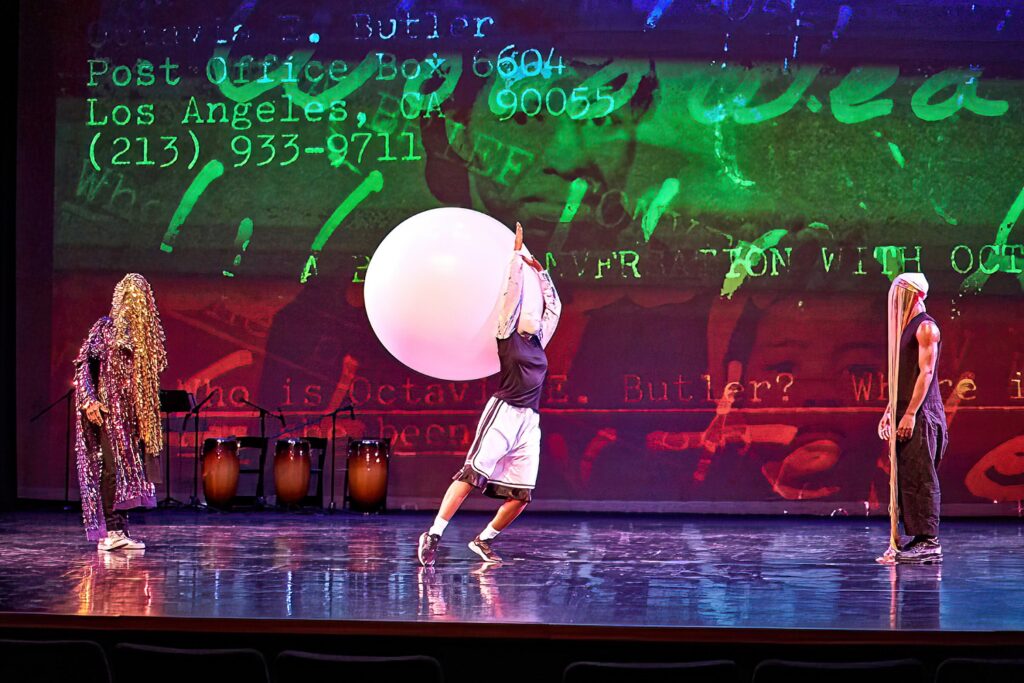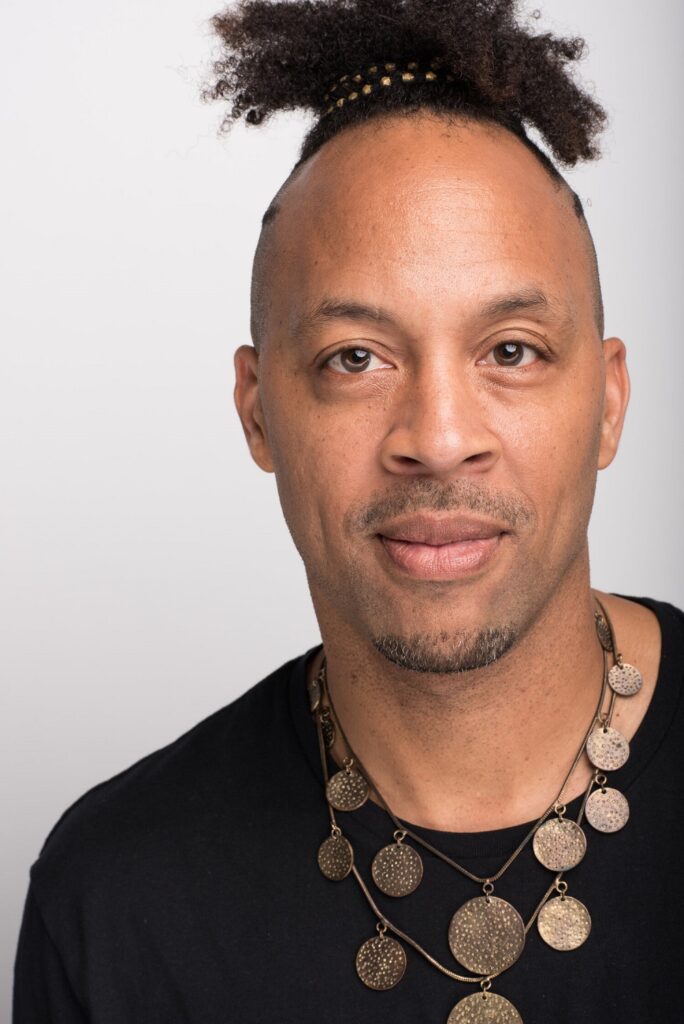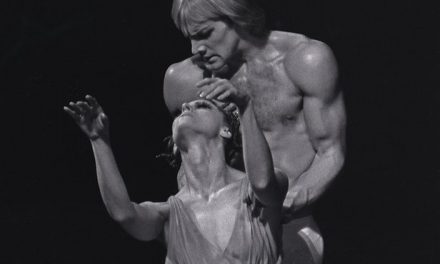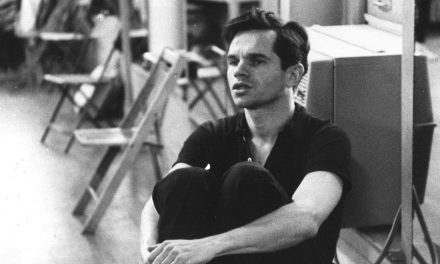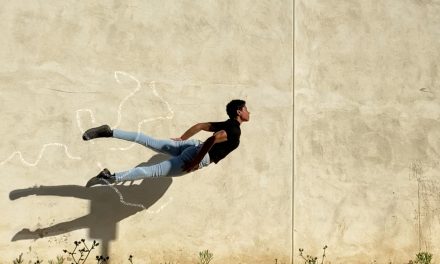Multidisciplinary artist d. Sabela grimes counts Octavia E. Butler as one writer who has had a profound impact on his life’s work. There are others, such as Toni Morrison, Sonia Sanchez, Alice Walker and Audre Lorde; however, on this particular day we met to discuss Butler and her influence on his Parable of Portals, which is showing on September 6, 2025 at 7:30 pm at Sierra Madre Playhouse. Tickets are on sale now.
Parable of Portals is a constellation of works that draws from Butler’s personal and professional manuscripts. Each module is autonomous, yet the whole is threaded through and opens up the possibilities for accumulation, reconfiguration (including subtraction) and relation. Each project carries the DNA of the others.
It all began as a short experimental film collaboration between grimes and Meena Murugesan, called “AdiSea DAWNing.” Shot on Catalina, the 5-minute film starred Adisah Grimes, his son, as the sole actor and mover and referenced his son’s name and Butler’s novel, Dawn. It screened at BlackStar Film Festival in Philadelphia in 2018 and at MOCA in Los Angeles in 2019.
grimes had also received the 2017 County of Los Angeles Performing Arts Fellow and took the opportunity to realize his intentions to make an explicitly Butler-inspired work, premiering Kinetic Vision at C.O.L.A. Night in 2018.
In 2019, grimes and Murugesan created a 3-channel video installation, DARK MATTER MESSAGES: Parable of Power, that was part of a multimedia exhibit at the Pearlstein Gallery in Philadelphia, curated by Maori Holmes, the founder of BlackStar Film Festival.
“Butler said she had to write herself in,” grimes said. “I said, I’m going to do it: make a more embodied dance-centered project around her work.”
Kinetic Vision was an extension of Butler’s term radio imagination, and grimes felt connected to both terms as a transmedia movement composer. Another chapter, or “star-like module,” in the constellation entitled, DARK MATTER MESSAGES: Parable of a Trickster, was performed at Lumberyard Center for Film and Performing Arts in Catskill, New York.
“Each work is a portal,” said grimes. “Transitions in between drafts are a portal. The idea of portals is woven throughout the work as a method, approach, way of entering, being in and exiting the project.”
The production is inspired by Butler’s Parable Series: Parable of the Sower and Parable of the Talents. She had planned a third novel, Parable of the Trickster, and had started and restarted but never finished because she passed away in 2006. Fortunately, she donated all of her writing—comprising 9,062 pieces—to the Huntington Library, a place with which grimes and Murugesan have become all too familiar. The two have spent hours diving into the collection.
“What stood out were her personal manuscripts but also the way she prepares and was invested in her craft,” grimes said. “The last thing I read of Octavia’s was Positive Obsession. I read seven drafts. That’s a different type of diligence. I am also a writer and reciter of words, but I have not been as diligent to sit with a text. I love the methodology.”
Choreographically, the creative direction of Parable of Portals deals with drafting.
“I will start and stop, you will see drafts of the same piece in several iterations or hear it in the music or see it in the visual architecture,” explained grimes.
“Dance is ephemeral,” he continued. “People don’t think of dance in relationship to Butler’s work. My work, Philly XP (2000), was speculative fiction. And 40 Acres & A Microchip (2003). Butler, through her ongoing research and daily observation of the humans she encountered, had a profound capacity to recognize patterns. It was central to her ability to imagine futures in a prophetic way. Therefore, I, too, see these patterns.”
Butler has certainly been hailed as prophetic, and grimes’ work is especially timely as Parable of the Sower takes place in 2024, tackling themes of climate science and political systems.
Another aspect of Butler’s work that guides grimes is her questioning and examining the human experience.
“It’s about world-building and imagining worlds, and not in outer space, but worlds here,” grimes said. “Worlds upon worlds. Parallel realities like here in South Central on the campus of USC.”
By his own account, grimes’ work is speculative, research driven, and myth making. He is trying to illustrate several parallel universes at the same time. He explores themes of inventiveness and malleability of identity.
“I’m not really interested in static blackness or presenting myself as, or adopting the idea of, a rigid idea of what black is,” said grimes.
What grimes is not is a provocateur.
“I am not aiming to make people uncomfortable,” he said. “I like things that push me, challenge me. My work challenges people.”
As a young person whose appetite was not for a neat, clean, respectable idea of what it means to be Black, grimes connected with Butler’s work as an undergrad at UCLA. It was also during these years that Louis Chude-Sokei, a T.A. for a literature course at the time and now a Professor of English at Boston University, handed him a mixtape of Black British music, which “changed who I am as songwriter and producer. The impact of the mixtape was being exposed to Black British music alongside what was also happening in the U.S. at the time. I felt that there was an amazing musical conversation happening among the African diaspora, especially since so many of the U.K.-based artist had Caribbean roots. You’ll hear the influence on my music, in my work. The impact of the mixtape was related to not just its content but the artful/thoughtful craft of putting together a mixtape—the thematic curation, order/flow/arc, cultural sampling and overall sonic cohesion. It planted a seed,” he said.
Two other influential figures that helped shape grimes’ creative character, particularly his sweet spot for sampling, were Michael “Mixxin” Moore, whose “Militant Master Mix” show on KCRW featured speeches layered over instrumentals and The Bomb Squad, who produced Public Enemy albums.
“I realized I can make instrumentals and recontextualize them with different sound bites,” said grimes. “The art and act of sampling. I do it musically and with movement.”
The chance to show Parable of Portals at Sierra Madre Playhouse has once again allowed grimes and Murugesan to reimagine it.
“In the past a lot of my work was more minimal,” grimes said. “I love designing costumes or styling around ideas. Meena brought a totally different visual architecture that compliments the lighting and the visual animations.”
The two shot film in L.A. and Seattle, geographical locations related to Butler’s and their lives. Places like Leimert Park, which was instrumental for grimes as a place of growth, dreaming and imagination since his late teens.
Parable of Portals pays homage to Butler and other inspirational artists who they fan out on, such as Kahlil Joseph and Julie Dash. They are inspired by their concepts, aesthetics and world building. Julie Dash’s interview with Butler is referenced in Parable of Portals.
It, like most of his work, puts emphasis on the methodology: the project as a seedbed for continuous creation.
“The way me and my collaborators are processing Butler’s work provides a ‘generative framework’,” he said.
As an Associate professor of Dance at USC Glorya Kaufman School of Dance, grimes shared what he considered to be the more structural/cultural limitations of teaching hip-hop outside the communities and cultural spaces where the practice was born and continues to be cultivated. His challenge is that hip-hop and street dance are community-based, social practices that cannot be fully replicated in a classroom or institutional context.
“We have sequences that are set, not fixed,” he explained. “These things I call movement meditations, guidelines or prompts for what’s possible. Inside of the set sequences is the possibility to improvise, which is really important. Black dance without improvisation is crazy to me. For black expressive forms and dance practices, improvisation is core, the willingness to surrender.”
On September 6, there will be improvisation, 3-D animated avatars and sampling. There will be the quiet inspo of Butler seen and heard throughout the entire production. And the audience will get to experience an artist playing with notions of blackness.
“I don’t know what it is, but I know what it is,” he said. “I speculate on what it is more than what it is not.”
Sabela grimes’ Parable of Portals appears at the Sierra Madre Playhouse on September 6, 2025 at 7:30 pm. For more information and to purchase tickets, please visit their website.
To learn more about d. Sabela grimes, please visit his website.
Written by Jessica Koslow for LA Dance Chronicle.
Featured image: d. Sabela grimes’ “Parable of Portals” – Photo by Jamie Kraus.

